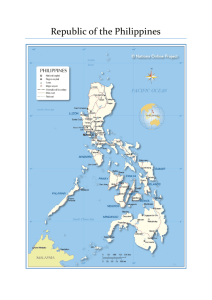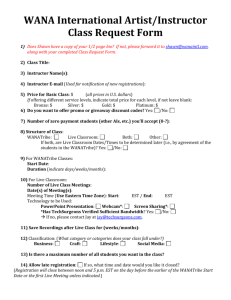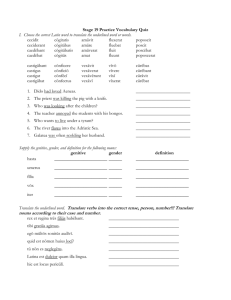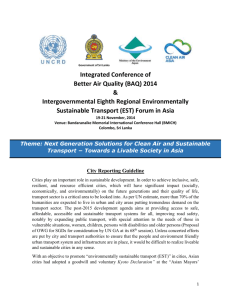Facts, Maps and Statistics Source: CIA World Factbook 2007, unless
advertisement
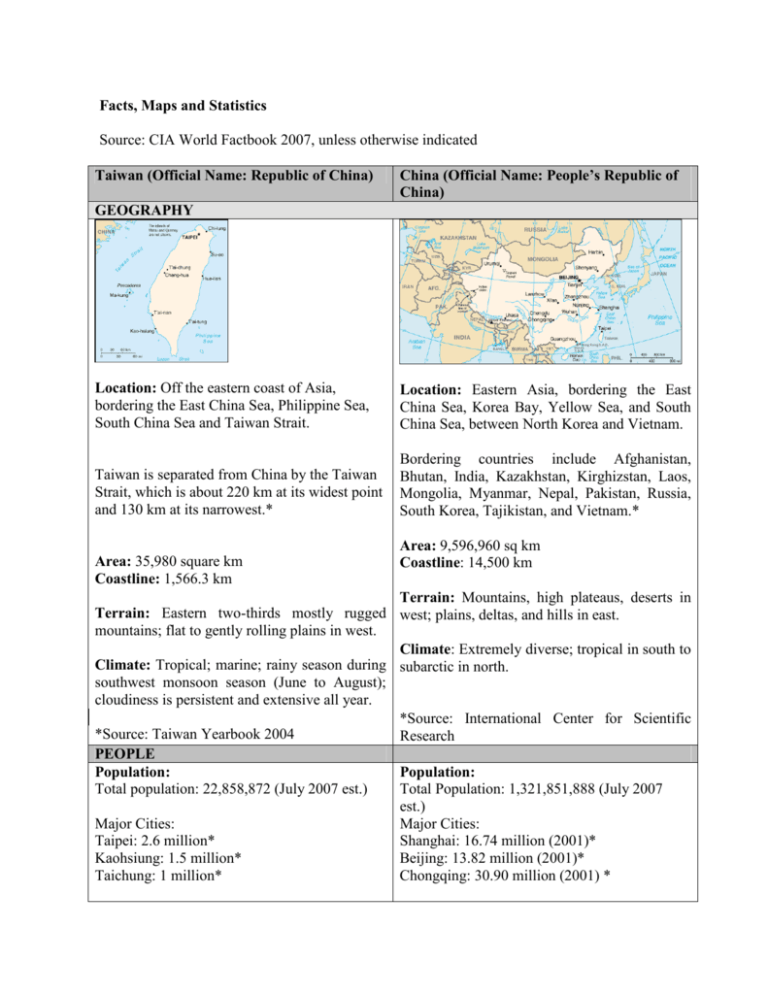
Facts, Maps and Statistics Source: CIA World Factbook 2007, unless otherwise indicated Taiwan (Official Name: Republic of China) China (Official Name: People’s Republic of China) GEOGRAPHY Location: Off the eastern coast of Asia, bordering the East China Sea, Philippine Sea, South China Sea and Taiwan Strait. Location: Eastern Asia, bordering the East China Sea, Korea Bay, Yellow Sea, and South China Sea, between North Korea and Vietnam. Taiwan is separated from China by the Taiwan Strait, which is about 220 km at its widest point and 130 km at its narrowest.* Bordering countries include Afghanistan, Bhutan, India, Kazakhstan, Kirghizstan, Laos, Mongolia, Myanmar, Nepal, Pakistan, Russia, South Korea, Tajikistan, and Vietnam.* Area: 35,980 square km Coastline: 1,566.3 km Area: 9,596,960 sq km Coastline: 14,500 km Terrain: Mountains, high plateaus, deserts in Terrain: Eastern two-thirds mostly rugged west; plains, deltas, and hills in east. mountains; flat to gently rolling plains in west. Climate: Extremely diverse; tropical in south to Climate: Tropical; marine; rainy season during subarctic in north. southwest monsoon season (June to August); cloudiness is persistent and extensive all year. *Source: International Center for Scientific *Source: Taiwan Yearbook 2004 Research PEOPLE Population: Population: Total population: 22,858,872 (July 2007 est.) Total Population: 1,321,851,888 (July 2007 est.) Major Cities: Major Cities: Taipei: 2.6 million* Shanghai: 16.74 million (2001)* Kaohsiung: 1.5 million* Beijing: 13.82 million (2001)* Taichung: 1 million* Chongqing: 30.90 million (2001) * Annual Population Growth Rate: 0.304% Birth Rate: 8.97 births/1,000 population Death Ratio: 6.54 deaths/1,000 population Sex Ratio: 1.026 male(s)/female (2007 est.) Annual Population Growth Rate: 0.606% Birth Rate: 13.45 births/1,000 population Death Rate: 7 deaths/1,000 population Sex Ratio: 1.06 male(s)/female (2007 est.) Age Structure 0-14 years: 17.8% (male 2,117,051/female 1,954,709) 15-64 years: 72% (male 8,306,351/female 8,141,268) 65 years and over: 10.2% (male 1,150,001/female 1,189,492) (2007 est.) Age Structure 0-14 years: 20.4% (male 143,527,634/female 126,607,344) 15-64 years: 71.7% (male 487,079,770/female 460,596,384) 65 years and over: 7.9% (male 49,683,856/female 54,356,900) (2007 est.) Health: (2007 est.) total: 5.54 deaths/1,000 live births Life Expectancy: 77.56 years Health: (2007 est.) Infant Mortality Rate: 22.12 deaths/1,000 live births Life Expectancy: 72.88 years (overall) Literacy: 97.3% (2005 est.)* Literacy: 90.9% (2004 est.) Languages: Mandarin Chinese (official), Taiwanese, Hakka. Ethnic Groups: Taiwanese (including Hakka) 84%, mainland Chinese 14%, indigenous 2% Religion: mixture of Buddhist and Taoist 93%, Christian 4.5%, other 2.5% *Source: U.S. Department of State Bureau of East Asian and Pacific Affairs (2007) Languages: Mandarin Chinese (official), Yue (Cantonese), Wu (Shanghaiese), Minbei (Fuzhou), Minnan (Hokkien-Taiwanese), Xiang, Gan, Hakka dialects, minority languages (see Ethnic groups entry). Ethnic Groups: 55 minority ethnic groups Han Chinese 91.9% Zhuang, Uygur, Hui, Yi, Tibetan, Miao, Manchu, Mongol, Buyi, Korean, and other nationalities 8.1% Religion: China is officially atheist Daoist (Taoist), Buddhist, Christian 3%-4%, Muslim 1%-2% (2002 est.) * Source: China Today Website ECONOMY GDP: $680.5 billion (2006 est.) GDP: $10.17 trillion (2006 est.) (GDP dollar estimate is derived from purchasing power parity (PPP) calculations.) (GDP dollar estimate is derived from purchasing power parity (PPP) calculations.) GDP per Capita: $29,500 (2006 est.) GDP per Capita: $7,700 (2006 est.) (GDP on a purchasing power parity basis divided by population as of 1 July for the same year.) (GDP on a purchasing power parity basis divided by population as of 1 July for the same year.) GDP Real Growth Rate: 4.6% (2006 est.) GDP Real Growth Rate: 10.7% (2006 est.) GDP Composition by Sector: Agriculture: 1.5% Industry: 25.5% Services: 73.3% (2006 est.) Inflation: 1% (2006 est.) GDP Composition by Sector: Agriculture: 11.9% Industry and construction: 48.1% Services: 40% (2006 est.) Inflation: 1.5% (2006 est.) Distribution of Income (Gini index): 32.6 (2000) Distribution of Income (Gini index): 44 (2002) Unemployment Rate: 3.9%. (2006 est.) Unemployment Rate: 4.2% official registered unemployment in urban areas; substantial unemployment and underemployment in rural areas (2005 est.) Population Below Poverty Line: 0.9% (2006 est.) External Debt: $93.06 billion (2006 est.) Natural Resources: Small deposits of coal, natural gas, limestone, marble and asbestos. Agriculture: products-- rice, corn, vegetables, fruit, tea; pigs, poultry, beef, milk; fish. Industry: Electronics, petroleum refining, armaments, chemicals, textiles, iron and steel, machinery, cement, food processing, vehicles, consumer products, pharmaceuticals Trade (2006): Exports--$215 billion f.o.b. (2006 est.): computer products and electrical equipment, metals, textiles, plastics and rubber products, chemicals (2002). Major partners-hina 22.5%, Hong Kong 15.7%, US 15%, Japan 7.3% (2006 est.) Imports-- $205.3 billion f.o.b: Population Below Poverty Line: 10% (2004 est.) External Debt: $305.6 billion (2006 est.) Natural Resources: Coal, iron ore, crude oil, mercury, tin, tungsten, antimony, manganese, molybdenum, vanadium, magnetite, aluminum, lead, zinc, uranium, hydropower potential (world's largest).* Agriculture: Major Products--Among the world's largest producers of rice, corn, wheat, soybeans, vegetables, tea, and pork; commercial crops include cotton, other fibers, and oilseeds.* Industry: Types -- mining and ore processing; iron; steel; aluminum; coal, machinery; textiles and apparel; armaments; petroleum; cement; chemicals; fertilizers; consumer products including footwear, toys, and electronics; automobiles and other transportation equipment including rail cars and locomotives, ships, and aircraft; and telecommunications. machinery and electrical equipment 44.5%, minerals, precision instruments (2002). Major partners -- Japan 23%, China 11.9%, US 10.9%, South Korea 7.2%, Saudi Arabia 4.9% (2006 est.) *Source: U.S. Department of State Bureau of East Asian and Pacific Affairs Trade (2006): Exports--$974 billion f.o.b: machinery and equipment, plastics, optical and medical equipment, iron and steel. Major partners-- US 21.4%, Hong Kong 16.3%, Japan 11%, South Korea 4.6%, Germany 4.3% (2005). Imports-- $777.9 billion f.o.b.: machinery and equipment, oil and mineral fuels, plastics, optical and medical equipment, organic chemicals, iron and steel. Major partners-- Japan 15.2%, South Korea 11.6%, Taiwan 11.2%, US 7.4%, Germany 4.6% (2005). *Source: U.S. Department of State Bureau of East Asian and Pacific Affairs GOVERNMENT Government Type: Multiparty democracy Government Type: Communist state Capital: Taipei Administrative Divisions: Includes main island of Taiwan plus smaller islands nearby and off coast of China's Fujian Province; Taiwan is divided into 18 counties, 5 municipalities, and 2 special municipalities. Capital: Beijing Administrative Divisions: 23 provinces: Anhui, Fujian, Gansu, Guangdong, Guizhou, Hainan, Hebei, Heilongjiang, Henan, Hubei, Hunan, Jiangsu, Jiangxi, Jilin, Liaoning, Qinghai, Shanxi, Shandong, Shanxi, Sichuan, Yunnan, Zhejiang. (Note - China considers Taiwan to be its 23rd province). Five Autonomous Regions: Guangxi Zhuang; Inner Mongolia; Ningxia Hui; Tibet (Xizang); Xinjiang Uygur. Constitution: 25 December 1947; amended in 1992, 1994, 1997, 1999, 2000, 2005. Constitution adopted on 25 December 1946; went into effect on 25 December 1947 Four Municipalities: Beijing, Chongqing, Shanghai, Tianjin. Two Special Administrative Regions: Hong Kong and Macau. Constitution: Most recent promulgation 4 Government Structure: December 1982. Executive Branch: Chief of state: President CHEN Shui-bian (since May 20, 2000) and Vice President Annette LU (LU Hsiu-lien) (since May 20, 2000) Head of Government: Premier (President of the Executive Yuan) CHANG Chun-hsiung since May 21, 2007) and Vice Premier (Vice President of the Executive Yuan) LIN Hsin-yi CHIOU I-jen (since May 21, 2007) Government Structure: Executive Branch: Chief of state: President HU Jintao (since March 15, 2003) and Vice President ZENG Qinghong (since March 15, 2003) Head of Government: Premier WEN Jiabao Cabinet: Executive Yuan - (ministers (since March 16, 2003); Executive Vice appointed by president on recommendation of Premier HUANG Ju (since 17 March 2003)Vice Premiers WU Yi (March 17, 2003), premier) ZENG Peiyan (since March 17, 2003), and HUI Legislative Branch: Unicameral Legislative Liangyu (since March 17, 2003). Yuan (225 seats - 168 elected by popular vote, 41 elected on the basis of the proportion of Cabinet: State Council appointed by the islandwide votes received by participating National People's Congress (NPC) political parties, 8 elected from overseas Chinese constituencies on the basis of the Legislative Branch: Unicameral National proportion of island-wide votes received by People's Congress or Quanguo Renmin Daibiao participating political parties, 8 elected by Dahui (2,985 seats; members elected by popular vote among the aboriginal populations; municipal, regional, and provincial people's to serve three-year terms). note: as a result of congresses to serve five-year terms). constitutional amendments approved by the now defunct National Assembly in June 2005, number of seats in legislature will be reduced from 225 to 113 beginning with election in 2007; amendments also eliminated National Assembly thus giving Taiwan a unicameral legislature Judicial Branch: Judicial Yuan (justices appointed by the president with consent of the Legislative Yuan). Legal System: Based on civil law system. Suffrage: 20 years of age; universal. Political Parties and Leaders: Democratic Progressive Party (DPP) Judicial Branch: Supreme People's Court (judges appointed by the National People's Congress); Local Peoples Courts (comprise higher, intermediate and local courts); Special Peoples Courts (primarily military, maritime, and railway transport courts). Legal System: Based on civil law system; derived from Soviet and continental civil code legal principles; legislature retains power to interpret statutes; constitution ambiguous on judicial review of legislation; has not accepted [YU Shyi-kun, Chairman]; compulsory ICJ jurisdiction. Kuomintang (KMT, or Nationalist Party) [WU Po-hsiung, chairman]; Suffrage: 18 years of age; universal. People First Party (PFP) [James SOONG, chairman]; Political Parties and Leaders: Taiwan Solidarity Union or TSU Chinese Communist Party (CCP) [HU Jintao, [HUANG Kun-hui, chairman]; General Secretary of the Central Committee]; Other minor parties including the Chinese New eight registered small parties controlled by Party (NP). CCP. MILITARY Branches: Army, Navy (includes Marine Corps), Air Force, Coast Guard Administration, Armed Forces Reserve Command, Combined Service Forces Command, Armed Forces Police Command. Military Manpower – Age and Obligation: 19-35 years of age for military service; service obligation 16 months (to be shortened to 14 months as of July 2007 and to 12 months in 2008). Military Manpower - Availability*: 5,883,828 (2005 est.) Military Manpower - Fit for Military Service*: 4,749,537 (2005 est.) Military Manpower - Reaching Military Age Annually**: 174,173 (2005 est.) Military Expenditures - Dollar Figure: $7,611.7 billion (2003) Military Expenditures - Percent of GDP: 2.2% (2006; to increase to 2.85% in 2007) * males age 19-49 ** males age 18-49 Branches: Ground Forces, Navy (includes marines and naval aviation), Air Force (includes airborne forces), and Second Artillery Corps (strategic missile force); People's Armed Police (PAP); Reserve and Militia Forces (2006) Military Manpower – Age and Obligation: 18-22 years of age for compulsory military service, with 24-month service obligation; no minimum age for voluntary service (all officers are volunteers); 18-19 years of age for women high school graduates who meet requirements for specific military jobs (2007). Military Manpower - Availability*: 342,956,265 (2005 est.) Military Manpower - Fit for Military Service*: 281,240,272 (2005 est.) Military Manpower - Reaching Military Age Annually*: 13,186,433 (2005 est.) Military Expenditures - Dollar Figure: $60 billion (2003) Defense Budget – Dollar Figure: $45 billion (2007)** Military Expenditures - Percent of GDP: 3.8% (2006) * males age 18-49 ** Department of Defense, Military Power of the People’s Republic of China 2007 INTERNATIONAL RELATIONS Participation in International Organizations: Asia Pacific Economic Cooperation (APEC), Asian Development Bank (AsDB), International Chamber of Commerce (ICC), International Red Cross and Red Crescent Movement (ICRM), International Federation of Red Cross and Red Crescent Societies (IFRCS), International Olympic Committee (IOC), International Trade Union Confederation (ITUC), World Confederation of Labor (WCL), World Trade Organization (WTO). Participation in International Organizations: African Development Bank (AfDB), Asia Pacific Economic Cooperation (APEC), Asia Pacific Telecommunity (APT), ASEAN Regional Forum (ARF), Asian Development Bank (AsDB), Association of Southeast Asian Nations (ASEAN) (dialogue partner), Banco Centroamericano de Integración Económica (BCIE) Bank for International Settlements (BIS), Caribbean Development Bank (CDB), East Asian Summit (EAS), Food and Agriculture Organization (FAO), Intergovernmental Group of Twenty-Four on International Monetary Affairs and Development (G-24) (observer), Group of 77 (G-77), International Atomic Energy Agency (IAEA), International Bank of Reconstruction and Development (IBRD), International Civil Aviation Organization (ICAO), International Chamber of Commerce (ICC), International Red Cross and Red Crescent Movement (ICRM), International Development Association (IDA), International Fund for Agricultural Development (IFAD), International Finance Corporation (IFC), International Federation of Red Cross and Red Crescent Societies (IFRCS), International Hydrographic Organization (IHO), International Labor Organization (ILO), International Monetary Fund (IMF), International Maritime Organization (IMO), International Criminal Police Organization (Interpol), International Olympic Committee (IOC), International Organization for Migration (IOM) (observer), Inter-Parliamentary Union (IPU), International Organization for Standardization (ISO), International Telecommunications Union (ITU), Latin American Integration Association (LAIA) (observer), Multilateral Investment Guarantee Agency (MIGA), United Nations Mission for the Referendum in Western Sahara (MINURSO), United Nations Observer Mission in the Democratic Republic of the Congo (MONUC), Nonaligned Movement (NAM) (observer), Nuclear Suppliers Group (NSG), Organization of American States (OAS) (observer), Organization for the Prohibition of Countries with Diplomatic Relations: Belize, Burkina Faso, Dominican Republic, El Salvador, Gambia, Guatemala, Haiti, Honduras, Kiribati, Malawi, Marshall Islands, Nauru, Nicaragua, Palau, Panama, Paraguay, Saint Kitts and Nevis, Saint Lucia, Saint Vincent and the Grenadines, Sao Tome and Principe, Swaziland, Solomon Islands, Tuvalu, Vatican City. Chemical Weapons (United Nations) (OPCW), Permanent Court of Arbitration (PCA), Pacific Islands Forum (PIF) (partner), South Asian Association for Regional Cooperation (SAARC) (observer), Shanghai Cooperation Organization (SCO), United Nations (UN), UN Security Council, United Nations Conference on Trade & Development (UNCTAD), United Nations Educational, Scientific and Cultural Organization (UNESCO), United Nations Human Rights Commission (UNHCR), United Nations Industrial Development Organization (UNIDO), United Nations Interim Force in Lebanon (UNIFIL), United Nations Institute for Training and Research (UNITAR), United Nations Mission in Ethiopia and Eritrea (UNMEE), United Nations Mission in Liberia (UNMIL), United Nations Mission in Sudan (UNMIS), United Nations Monitoring, Verification and Inspection Commission (UNMOVIC), United Nations Operation in Cote d’Ivoire (UNOCI), United Nations Truce Supervision Organization (UNTSO), United Nations World Tourism Organization (UNWTO), Universal Postal Union (UPU), World Customs Organization (WCO), World Health Organization (WHO), World Intellectual Property Organization (WIPO), World Meteorological Organization (WMO), World Trade Organization (WTO), Zangger Committee (ZC) Countries with Diplomatic Relations: China conducts official diplomatic relations with almost all nations.

